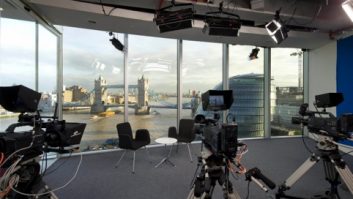
By Mark Errington, chief executive officer, OASYS.
Imagine a scenario where a customer has ordered a new television service. His supplier sends him all of the equipment to install for this service. The customer is expecting a simple set top box, but instead he receives a video player/recorder, an SD/HD converter, a graphics system, an aspect ratio converter, a sub-title system, a vision mixer, and a number of cables to connect all this equipment together.
The customer is confused. He doesn’t understand why all of this can’t be done in one box. Just how complicated can it really be?
Broadcasters would obviously find it very difficult to sell this service to their customers. Which is ironic as this may well be exactly what they have in place behind the scenes to actually deliver the service. But behind the scenes will be broadcast engineers talking about esoteric terms like ‘broadcast quality’ and ‘tapeless workflow’, and about how their jobs are safe because they bought the broadcast equivalent of IBM. Probably the same engineers who now carry a mobile phone around that has more functionality than a laptop did ten years ago.
Why then does the broadcast industry have such reluctance to accept automated playout systems, AKA a channel in a box? Why do the industry’s major suppliers need to deride these systems as ‘limited functionality’, or not ‘broadcast quality’ (although the definition of that term could take a series of articles to explain). Is it possibly because the industry holds the wrong perception that low cost equals low quality? Or is it possibly because the major suppliers have embraced this technology many years after its introduction, being followers rather than leaders in this field?
It is interesting that proponents of the old ‘GPI’ based model are now enriching their solutions to be much more like the channel in a box solutions, but heralding them as if they are the new dawn in broadcast engineering. The reality is that several suppliers have been developing these solutions for over 15 years, and they are now a mature technology, not bleeding or even leading edge.
The issue (or possibly even the mistake) of the leading edge companies from 15 years ago was competing not on functionality, simplicity, efficiency, or quality, but on price. In the last few years Apple has done a sterling job in promoting FCP to be a key editing solution of choice. However, the Apple brand has much to answer for in this regard, as although the pricing of the product has been very competitive, customers were prepared to risk taking the lower priced solution as they trusted the quality of the brand.
The forerunners of the channel in a box revolution did not have that advantage and, despite the quality of the products, have always struggled to gain the trust of the mainstream broadcast community — demonstrated by this magazine feature being the first to seriously address this market segment.
Super video server
My company, and I’m sure others, have channel in a box solutions that are still operational after more than ten years of service, which, given the technology developments in that time, demonstrates the robustness of the architecture. Given also that features are generally added in software and not in hardware, it means that this creates significant returns on investment.
So what, apart from the lack of trust, has held back this technology from being mainstream? Well this is where the broadcast engineering versus IT debate comes in. PCs, as the common mis-perception goes, are not ‘broadcast quality’. Are they frame accurate, fault tolerant, and provide seamless glitch free playback?
Even if they are not, does that make them any better or worse than traditional automation systems with their array of devices? I would ask anyone who questions this to watch BBC ONE; look at the frame jitter that happens every time when the title credits are squeezed back, and ask what kind of system provides that level of ‘broadcast quality’ (and I think you will find it is not a channel in a box).
Does it really make sense that a GPI trigger to an external device is more efficient that a piece of software code operating on the same system? Does it really make sense that traditional solutions are all engineering and no IT? Of course not. The modern video server is after all, a single function PC, and the speed and reaction of internal processes must be more reliable than an external electrical command.
So if you think of a channel in a box not as a PC but as a Super Video Server, you are actually much closer to the realisation that broadcast and IT are now such a hybrid technology that this is not only mainstream, it is the way of the future. True mixed file format playout minimising transcoding; redundancy in a self contained unit; real AS-RUN logging; unified playout information; and simplified support; are only a part of the list of advantages.
What, however, of a multichannel scenario? Is this scalable? Scalability is actually ultimate simplicity. Channel in a box systems are nothing more than a local cache of materials, all of which are copied from a centralised storage solution. So, they interact with the entire broadcast workflow from acquisition, through asset management, and scheduling. Most interact using XML-based interfaces (which after all is the basis of one of the major new standards – BXF), and some are even self-managing, automatically purging the unwanted materials.
Are they compatible with legacy automation systems? After translating a simple on/off trigger into an internal command, most legacy automation systems can be replicated so channel in a box solutions can run alongside, or as disaster recovery for existing facilities, often able to provide more functionality than the systems they sit next to. With only one supplier to deal with support is generally simpler and easier, and not only can new channels be started in a matter of days, functionality changes are normally made only in software.
So, maybe the trick would be for the channel in a box vendors to charge a much more comparative price for their offering. Maybe the power consumption and support efficiencies would be enough cost saving justification. Maybe when the question is asked as to how a traditional automation solution is so superior to a channel in a box solution, and there is no real answer, the perception will change to the reality that automated playout solutions are broadcast quality.





